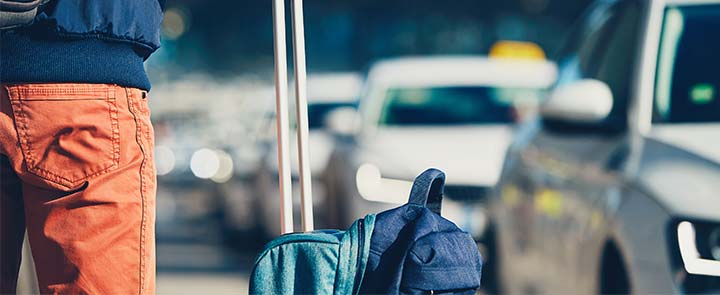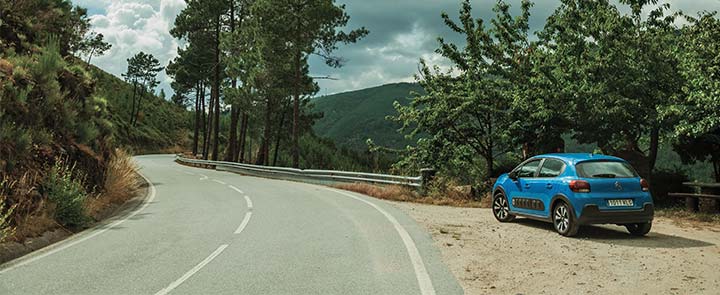
When travel writers compile lists of the best road trips in the world, driving in Europe features heavily. With dramatic scenery connected by some of the world’s greatest roads, it's not hard to see why!
While most countries in the European Union use similar signs and speed limits, countries have their own driving quirks. Our guide will help you prepare for driving in Europe.
Roads in Europe
Almost every country has an equivalent to motorways, A roads, and B roads. Although some, like Montenegro, don’t have motorways. While most countries in Europe use similar signage, there are some minor differences in design. For this reason, it’s best to familiarise yourself with these before getting behind the wheel.
- Autoroutes/Autobahns/Autopistas/Autostrade etc.
They can normally be recognised by white text on a blue background or white text on a green background. Speed limits are either 120km/h or 130km/h under normal conditions.
- Primary roads
These connect motorways with major towns and cities. The speed limit is typically between 80 - 90 km/h, and in most places the signs are white on green or white on blue.
- Secondary roads
These are typically smaller connector roads, and are also found within towns and cities. They are signposted with black text on a white background, and there is a normally a speed limit of 50 km/h.
How to drive in Europe
The best advice on how to drive in Europe is simply to take a defensive approach until you feel comfortable. You should follow the rules of the road closely and get familiar with local driving customs. It’s also sensible to plan your route in advance, so you can give your full attention to traffic.
Europe driving rules
To help you out, we have guides on driving in some of Europe’s most popular destinations.
If you follow the guidelines below, they will help you to stay safe and to follow the rules the country you are visiting:
- Don’t drink and drive: All European countries have strict alcohol limits, so it’s never worth the risk.
- Keep your lights on: Many countries – especially those in northern Europe – require you lights on all year round, all day long.
- Be aware of low-emission zones. Many major cities in Europe do not permit cars with high emissions at certain times.
- Pack the necessary safety equipment. Most countries expect you to have a reflective safety vest in your car in case of a breakdown, and one (or even two) red safety triangles. In France you also need a breathalyser, which your car hire firm should provide for you.
- Don’t use your phone: It’s against the law in almost all European countries to call or text on a mobile phone while driving.
- Keep your kids in the back: In many countries, children under the age of 12 are not allowed in the front seat.
- Always wear a seat-belt: Wearing a seat-belt is obligatory for drivers and passengers across Europe.
Where doesn’t drive on the right in Europe?
Almost every country in Europe drives on the right, apart from:
- The UK
- Republic of Ireland
- Malta
- Cyprus
Who has right of way in Europe?
In almost all cases, drivers on the main road have right of way in Europe. These is an exception to this for in a (gradually decreasing) number of locations in France, where priorité à droite still exists. This is an odd rule to get your head around, but it allows the traffic entering the road at certain junctions to go first. You can spot these junctions by their red-edged triangular signs that have a black cross on a white background.
Some European cities have tram systems, which almost always have priority over car traffic. It’s also worth brushing up on cycling laws. In some countries, like the Netherlands, bicycles have priority over motorised vehicles on roundabouts.
Finally, watch out for local customs. In Spain, for example, the side of the road you can park on might switch depending on the day it is. In Italy, you may not be allowed to drive in a city’s ‘old town’ on certain days. On-street signage should alert you to these peculiarities.
What is the speed limit in Europe?
The speed limit in Europe is largely the same across the continent, but with certain idiosyncrasies:
- Motorways: 120-130 km/h – although there are some notable exceptions:
- Germany’s Autobahn famously doesn’t have a speed limit, although that isn’t always the case, as is explained in this infographic.
- France has variable speed limits depending on the weather, so if it’s too hot or rainy, you need to drive more slowly. This lower speed limit is denoted on the speed panel.
- Police in Scandinavian countries may regulate the speed limit on a daily basis, depending on visibility and driving conditions.
- Principal roads: 90 – 90 km/h
- Secondary and urban roads: 50 km/h
- Residential areas and near schools: 30 km/h
Driving in adverse conditions in Europe
While much of Europe has a temperate climate, northern Europe deals with heavy snow in winter and limited light during the day. Also, driving in mountainous regions, such as the Alps, may require different behaviour behind the wheel:
- Drive with your lights on at all times in countries where this is the law
- Carry winter tyres or chains and put them on your car in case of snow
- Prepare your route and visit the country’s highway authority website for weather news
- Carry emergency equipment in your car
- Bring food and a sleeping bag if you're driving in snowy conditions
Driving hazards in Europe
While Europe’s roads are mainly well-maintained and enjoyable to drive on, there are a number of hazards to watch out for:
- Other drivers: Different countries have different attitudes to driving (and worse reputations!), so you will have to adapt to a style which might seem more aggressive at first.
- Speed cameras: You should also be aware that it’s against the law to use any speed camera detection technology in France.
- Extreme weather: Be prepared for ice, snow and fog in northern Europe in winter. In the summer, beware of your vehicle over-heating in southern Europe.
- Poor quality roads: In some countries, roads are less well-maintained, so drive with caution and watch out for potholes.
If anything does go wrong, get directly in touch with your car hire company. If there’s been an accident, you can call the emergency services anywhere in the EU on 112.
Europe driving tips
Here are some driving tips to make sure your journey around Europe is hassle-free:
- Cash for tolls: Many countries operate toll roads. While you can pay with card, it’s often easier to toss some coins into the machine, so keep loose change close at hand.
- Plan your route: Your GPS will be useful, but it’s wise to bring a map in case of poor signal.
- Familiarise yourself with the rules. Using the European Commission's Going Abroad website will give you the background you need for the country you are visiting.
- Drive defensively: Take it easy on the roads and don’t be bullied into exceeding the speed limit.
More information
Your experience of driving in Europe should be an odyssey to remember for years to come. More information about driving in Europe can be found at:
- ViaMichelin: Michelin offers tips and allows you to explore routes based on whether you want to get from A to B.
Do you need to make a claim?
If you’ve suffered damage to or loss of your hire vehicle due to theft, and you’ve purchased an insurance4carhire hire car excess insurance policy, we’re ready to help.
Related Guides

A Guide to Car Hire Costs
We like to think our car excess insurance is nice and straightforward. Your car rental agreement, however, might not be so easy to understand. With this in mind, we’ve put together a guide to car hire costs.

A Guide to Car Hire from the Airport
There are thousands of car rental desks across airports round the world, competing against each other in small spaces. In this guide, we’ll explore whether it could be more beneficial to leave the airport before hiring a car for your trip.

Guide to Parking in Europe
The experience of driving a hire car in a new country can be stressful and understanding the rules around parking can be confusing. Parking regulations and rules in can be very different from what you may be used to in the UK.


